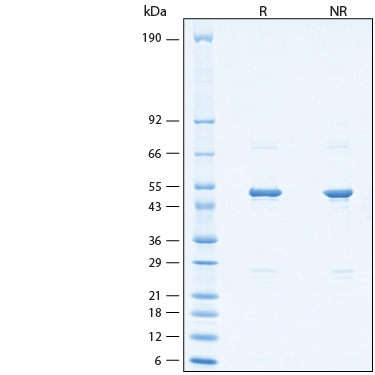Recombinant SARS-CoV-2 Nucleocapsid His-tag Protein, CF
Recombinant SARS-CoV-2 Nucleocapsid His-tag Protein, CF Summary
Product Specifications
Met1-Ala419 (Arg203Lys, Gly204Arg), with a C-terminal 6-His tag
Analysis
Product Datasheets
Carrier Free
CF stands for Carrier Free (CF). We typically add Bovine Serum Albumin (BSA) as a carrier protein to our recombinant proteins. Adding a carrier protein enhances protein stability, increases shelf-life, and allows the recombinant protein to be stored at a more dilute concentration. The carrier free version does not contain BSA.
In general, we advise purchasing the recombinant protein with BSA for use in cell or tissue culture, or as an ELISA standard. In contrast, the carrier free protein is recommended for applications, in which the presence of BSA could interfere.
10898-CV
| Formulation | Lyophilized from a 0.2 μm filtered solution in PBS with Trehalose. |
| Reconstitution | Reconstitute at 500 μg/mL in PBS. |
| Shipping | The product is shipped at ambient temperature. Upon receipt, store it immediately at the temperature recommended below. |
| Stability & Storage: | Use a manual defrost freezer and avoid repeated freeze-thaw cycles.
|
Scientific Data
 View Larger
View Larger
2 μg/lane of Recombinant SARS-CoV Nucleocapsid His-tag Protein (Catalog # 10898-CV) was resolved with SDS-PAGE under reducing (R) and non-reducing (NR) conditions and visualized by Coomassie® Blue staining, showing bands at 47-53 kDa.
Reconstitution Calculator
Background: Nucleocapsid
SARS-CoV-2, which causes the global pandemic coronavirus disease 2019 (Covid-19), belongs to a family of viruses known as coronaviruses that are commonly comprised of four structural proteins: Spike protein (S), Envelope protein (E), Membrane protein (M), and Nucleocapsid protein (N) (1). While the S, E and M proteins build up the viral envelop, the N protein is involved transcription, replication and packaging of the viral RNA genome into a helical ribonucleocapsid (RNP) (2, 3). The SARS-CoV-2 N protein is a ~45 kDa protein composed of two independent structural domains connected by a linker region. The N-terminal region contains an RNA binding domain, the linker region interacts with the M protein and the C-terminal region contains a self-association domain (2, 3). The SARS-CoV2 N protein shares 91% and 47% amino acid sequence identity with SARS-CoV-1 and MERS N protein, respectively. The SARS-CoV-2 N protein displays VSR (viral suppressor of RNA interference) activity in mammalian cells (4). In addition, the N protein is an abundant protein during coronavirus infection and displays high immunogenic activity (5, 6), so it has been used to develop serological diagnostic kit for Covid-19 IgM and IgG antibody tests (7). The co-occurring mutations R203K/G204R within the N protein were carried by some high transmissibility variants, including B.1.1.7 and P.1. It was reported that the R203k/G204R mutations contributes to the increased transmission and virulence of the SARS2-Cov-2 variants (8).
- Wu, F. et al. (2020) Nature 579:265.
- Chang, C. K. et al. (2006) J. Biomed. Sci. 13:59.
- Hurst, K.R. et al. (2009) J. Virol. 83:7221.
- Mu, J. et al. (2020) Sci. China Life Sci. doi: 10.1007/s11427-020-1692-1.
- Che, X. Y. et al. (2004) J. Clin. Microbiol. 42:2629.
- Guan, M. et al. (2004) Clin. Diagn. Lab. Immunol. 11:287.
- Liu, W. et al. (2020) J. Clin. Microbiol. doi: 10.1128/JCM.00461-20.
- Wu, H. et al. (2021) bioRxiv https://www.biorxiv.org/content/10.1101/2021.05.24.445386v1.
FAQs
No product specific FAQs exist for this product, however you may
View all Proteins and Enzyme FAQsReviews for Recombinant SARS-CoV-2 Nucleocapsid His-tag Protein, CF
There are currently no reviews for this product. Be the first to review Recombinant SARS-CoV-2 Nucleocapsid His-tag Protein, CF and earn rewards!
Have you used Recombinant SARS-CoV-2 Nucleocapsid His-tag Protein, CF?
Submit a review and receive an Amazon gift card.
$25/€18/£15/$25CAN/¥75 Yuan/¥1250 Yen for a review with an image
$10/€7/£6/$10 CAD/¥70 Yuan/¥1110 Yen for a review without an image
